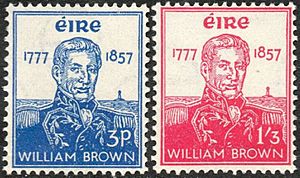Seán O'Sullivan (painter) facts for kids
Quick facts for kids
Seán O'Sullivan
|
|
|---|---|
| Born | 20 June 1906 Dublin, Ireland
|
| Died | 3 May 1964 (aged 57) Dublin, Ireland
|
Seán O'Sullivan (born June 20, 1906 – died May 3, 1964) was a talented Irish painter and designer. He was especially known for painting portraits of famous people and for designing many of Ireland's postage stamps.
Contents
Early Life and Art School
Seán O'Sullivan grew up in Dublin, Ireland. He went to school at Synge Street CBS. After that, he studied art at the Dublin Metropolitan School of Art. He was very good at drawing and even won a special scholarship!
He also traveled to London and Paris to learn more about art. In London, he studied how to make prints using a method called lithography. In Paris, he learned painting at famous art schools like Colarossi's.
Seán O'Sullivan married another painter named Renée Mouw. They had two daughters, Julian O'Sullivan and Terry Myler. Terry Myler followed in her parents' footsteps and became a book illustrator.
A Career in Art
Seán O'Sullivan started showing his artwork when he was just 20 years old. This was in 1926 at the Royal Hibernian Academy (RHA). He continued to show about six new paintings there every year until he passed away.
He was mostly known for his portraits. A portrait is a painting of a person. Seán O'Sullivan painted many important Irish leaders and cultural figures. These included presidents like Éamon de Valera and Douglas Hyde. He also painted famous writers like W. B. Yeats and James Joyce.
In 1930, he designed the cover for a special book called the Capuchin Annual. His art was even part of the painting event at the 1932 Summer Olympics!
Designing for Books and Stamps
Seán O'Sullivan was a busy designer. In 1932, he created many illustrations for the Saorstát Eireann Official Handbook. This book was about the Irish government at the time.
One of his most famous designs was a funny "Irish map of the world." This map was for a book called An Béal Bocht (which means The Poor Mouth). On the map, O'Sullivan only marked places that were important in a funny way. For example, he showed Sligo Jail in Ireland and routes to Scotland. He also joked about places where illegal alcohol was hidden. For the United States, he only marked New York, Boston, and Springfield. For England, he only mentioned Irish playwright George Bernard Shaw. This map was made to make people laugh!
He also designed covers for poetry books and made funny drawings for a book about Dublin called So this is Dublin!.
Murals and Landscapes
Seán O'Sullivan also painted large pictures called murals. In 1933, he designed the Stations of the Cross for a church in Ballingtogher, County Sligo. In 1942, he painted murals showing a wedding in west Ireland for a bar in Tullamore. He also painted murals for a hospital in Drogheda in 1958.
Throughout the 1950s, he painted many beautiful landscapes of southern and western Ireland. One popular painting is 'Lough Gill' from 1953. You can see this painting at the Irish Museum of Modern Art today.
Famous Stamp Designs
Between 1943 and 1957, Seán O'Sullivan designed many commemorative stamps for the Irish Post Office. These stamps celebrated important people and events.
He designed stamps with his paintings of Douglas Hyde and Sir William Rowan Hamilton in 1943. In 1944, he designed a stamp for Edmund Ignatius Rice. Later, in 1966, his paintings of the seven leaders who signed the Irish proclamation were used on stamps. These leaders included Éamonn Ceannt, James Connolly, Joseph Plunkett, Patrick Pearse, Seán MacDiarmada, Thomas MacDonagh and Tom Clarke.
Later Life and Legacy
Seán O'Sullivan never stopped working. In April 1964, when he was 58, he had a stroke while painting a portrait. He passed away shortly after, on May 3, 1964, in Nenagh general hospital. His funeral was held in Dublin, and he was buried in Deans Grange Cemetery.
His death was remembered at the opening of the Royal Hibernian Academy's art exhibition in May 1964. Many of his friends and fellow artists spoke about him. Important people like Taoiseach (the Irish Prime Minister) Seán Lemass also attended. The Irish Times newspaper described O'Sullivan as a "big, double bass-voiced artist who had a dual genius – for unequalled draughtsmanship and for living." This means he was a great artist and also lived life to the fullest.
His Art Lives On
Many of Seán O'Sullivan's artworks are still on display today. His portrait of former Irish President Éamon De Valera can be seen at Áras an Uachtaráin, which is the official residence of the President of Ireland.
Some of his paintings and sketches have been sold at auctions. For example, his painting 'The Man and Woman of the West' (from 1929) sold for a lot of money in 2008. In 2012, a special sale was held in Dublin just for his artworks.
You can find many of O'Sullivan's portraits and sketches at the National Gallery of Ireland (NGI) in Dublin. These include portraits of famous people like Jack Butler Yeats, James Larkin, and Maude Gonne. Some of his works are also kept in special collections at University College Dublin. His art helps us remember important Irish cultural, political, and social figures from the early to mid-1900s.
Seán O'Sullivan also helped preserve the history of Great Blasket Island. This island is no longer inhabited, but his 1958 portrait of Peig Sayers is part of The Blasket Foundation's collection. This foundation works to save the history and culture of the island community. His sketch 'A Blasket Islander' (from 1932), which shows an elderly islander, was sold at an auction in 2021.
|



